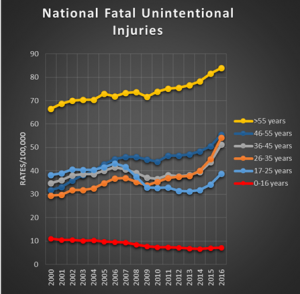
Deaths resulting from injuries – both violent and unintentional – are on the rise in the U.S., according to an August 2018 research letter published in JAMA Surgery.
Injuries are the leading cause of death among people under age 44, and the third-highest ranking cause of death overall, Angela Sauaia, corresponding author on the paper and professor of public health, medicine and surgery at the University of Colorado, told Journalist’s Resource.
Sauaia’s research team, based out of the Denver Health Medical Center and the University of Colorado, looked at an online database that collects statistics on fatal injuries. The database, WISQARS (Web-based Injury Statistics Query and Reporting System) uses information from the U.S. Centers for Disease Control and Prevention’s National Vital Statistics System, which collects death certificate data (among other vital statistics) across the country and in five territories.
The study team analyzed data collected for all ages between 2000 and 2016 to look at changes in fatal injuries over time and by race/ethnicity and type. Injury type was broken into three categories: homicides, suicides and unintentional (this last category includes falls and motor vehicle fatalities, among other accidents). Sauaia stressed that the research is “certainly an underestimation of the problem” given that most injuries, both violent and accidental, are not fatal.
Here’s what the team found:
- Overall fatal injury rates increased significantly from 2014 to 2016, reversing earlier reductions.
- Breaking the analysis down further, violent and unintentional injury fatalities each spiked between 2014 and 2016. These sharp increases applied to all the racial/ethnic groups studied.
- In a phone interview with Journalist’s Resource, Sauaia put numbers to the recent increases, noting that there were 64,876 fatalities due to violent injuries in 2016, and 161,374 fatalities due to nonviolent injuries that year. By comparison, in 2014, there were 59,213 fatalities due to violent injuries and 135,928 fatalities due to nonviolent injuries.
- Motor vehicle-associated fatalities increased between 2014 and 2016, “after more than a decade of steady, significant declines,” the paper notes.
- Black individuals experienced the sharpest spike in homicide fatality rates between 2014 and 2016. They also had the highest rates of homicide fatalities of all the racial/ethnic groups throughout the entire study period.
- Two-thirds of homicides studied were firearm related.
- Firearm-related suicides increased significantly from 2006 to 2016, after a decrease from 2000 to 2006. Analyzed by race, suicides increased for white and black individuals from 2006 onward. For Latino individuals, suicides began to increase starting in 2013.
- Firearms were involved in about half of all suicide fatalities throughout the entire time period.

“To see these upward trends was surprising and disturbing,” Sauaia said, given that they had observed survival gains earlier in the 2000s. “We need to figure out why we had these upturns,” she continued. The study did not offer potential explanations for these trends.
Though further research is needed to clarify the drivers of these trends, Sauaia argued that “several policy solutions are obvious and can be implemented right away.”
“I used to say that you don’t have to understand why fire burns you before you remove your hand … We don’t need to know causes before we can start implementing potential solutions,” she said.
Given the high fatality rate associated with firearm-related injuries (1 in 3 people injured by a firearm dies), and the increasing prevalence of these fatalities, her first top-of-mind policy suggestion is to designate federal funds for gun research.
Currently, the Dickey Amendment prevents CDC research funding from supporting projects that “may be used to advocate or promote gun control.” The National Rifle Association lobbied for the amendment, authored by Jay Dickey, a former Republican U.S. Representative for Arkansas’ 4th congressional district. It was adopted in 1996, and remains in place despite congressional attempts to eliminate it.
“We need money to assess causes, to implement solutions, to evaluate the solutions and determine whether they work,” Sauaia said. She noted that her research was funded in part by her university and in part was uncompensated work undertaken over “a lot of weekends.”
She also suggested implementing what she considers to be an uncontroversial gun control policy – smart guns. Sauaia elaborated that smart guns would only unlock for an authorized user – the gun’s owner, who has been checked and deemed mentally stable and emotionally capable of using it.
“Children should not have access to loaded, unlocked guns,” she said. “We do have the technology. Our phones are smart, why don’t we have guns that are smart?”
